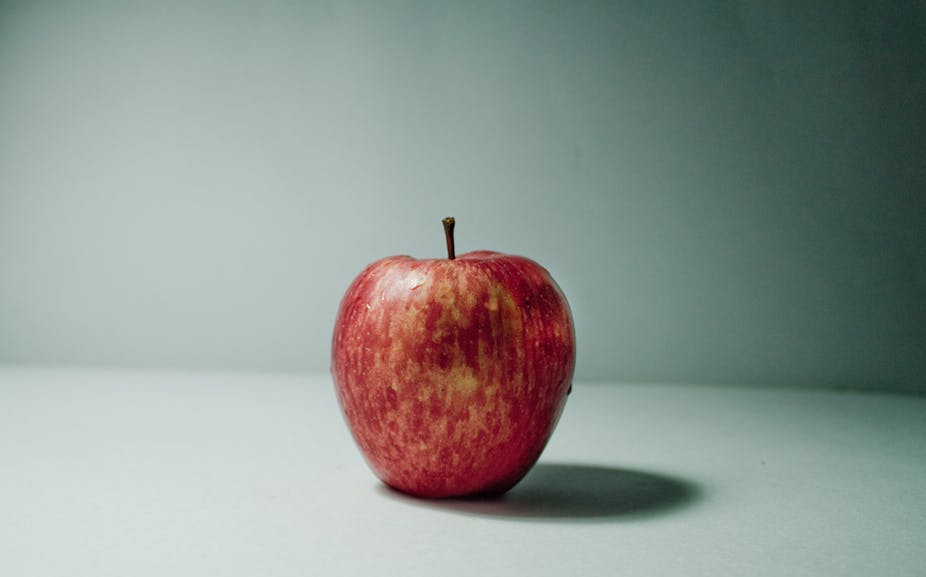One of the best tricks of making a horror movie is not to show too much, allowing the imagination to create the monster. We can’t see molecules, which is what makes them scary. We fill this vacuum with fairy stories about what molecules are. We stereotype them as toxic, or dangerous.
To say chemicals are toxic is rather like saying people are bad. Some are. Most aren’t. It depends. Most molecules you meet are not dangerous, which helps explain why you’re alive.
My students and I work with molecules every day: we study what they do, and how to make them. None of us has ever seen a molecule with our naked eyes, but we know they’re there, and what they look like. Understanding molecules is like learning a language: it takes time, but eventually you come to see the beauty.
Just as a language can be used to create things that are beautiful, or ugly, inspiring or harmful, so atoms can be arranged to form molecules that are tasty or toxic, fragrant or explosive.
“Molecule” is another word for “chemical”. Typically we talk about a molecule as a single thing, and a chemical as a collective – rather like a person is part of a population. The whole world consists of molecules – we are immersed in them. But never is our relationship as intimate as when we eat them.

Food is a bunch of chemicals, nothing more, nothing less. When we eat, we eat chemicals. Some are simple, such as water or salt. Some are complex, such as the proteins in steak. But they’re all chemicals.
There is no part of food that is not chemical. If you eat an apple that weighs a hundred grams, you have eaten a hundred grams of chemicals.
Why are people alarmed by this idea? It’s partly that the word “chemical” has had a bad public relations run. There’s a feeling that natural “things” are good for us, but synthetic “chemicals” are bad.
This is, of course, nonsense. I work on a drug given to people suffering from the parasitic disease Bilharzia, which is extraordinarily effective. Millions of lives have been transformed. The drug is a synthetic chemical that does not occur in nature.
Humanity discovered it by making it. We should be proud. I’m not so keen on strychnine, although you find that in nature. I’d rather not.
The chemicals that make up our food are things we’ve evolved to eat so are typically good for us – that’s why they’re part of our diet.
We’ve co-evolved with the apple so that we find it tasty. It’s tasty because there are a load of chemicals in the apple that fit into things on our tongue that fire neurons to our brain in a pattern that the brain interprets as “tasty”.
We don’t like a moldy apple because there are different chemicals in there that are warning us the apple’s no longer good to eat. Our sense of taste and the apple developed in tandem. If we welcomed our alien overlords to Planet Earth with a gift basket of apples, it’s touch-and-go whether that would go down well.
We can make the chemicals responsible for these nice tastes in the lab. Many of those chemicals are organic molecules (meaning they are constructed of a framework of the chemical carbon, not that they have been reared on a free-range farm).
Many of the chemicals are metal ions such as iron and copper that we need for our bodies to function – the same elements we find in cars and buildings.
The reason we can’t make a taste exactly like an apple in a lab is because the apple taste is a symphony of chemicals, rather than just one. It’s hard for us to make an apple.
We can approximate it by making some of the things in apples, and those chemicals would be exactly the same as the ones in the apple that was grown, but it’s not likely we’re going to make a synthetic apple any time soon. Why bother? The tree makes the chemical symphony just fine using sunlight, water and air.

I enjoy understanding the molecular nature of things. I know the structure of the molecule that’s responsible for the colour of red wine. When I look at the molecular structure I find it beautiful, and when I look at red wine I sometimes think of that molecule, and its trillions of brothers, tumbling through my glass and catching the light.
When I sip wine I think about all the chemicals going into my body, and the incredible sophistication of my handling all the molecular diversity I’m drinking.
The alcohol goes one way, the red colour goes another, and all the other molecules go their different ways in a seamless process my ancestors developed.
I repurpose the chemicals I eat to construct the fabric of my body, such as the chemical in my blood that lets me use oxygen, or the chemical in the back of my eye that lets me see.
This choreography with the chemicals we eat happens because I am a chemical thing. I consume chemicals and enjoy them because I am a creature of chemical evolution.
I need chemicals to survive, and to enjoy life. I take in chemicals and they become part of me. When I die, I’ll return myself to the earth and perhaps become part of an apple. Our world, in all its breathtaking diversity, is completely composed of chemicals.
As this is the International Year of Chemistry we ought to remember this idea, and treat the word “chemical” with the respect it deserves – as a broad but accurate description of what we are.

